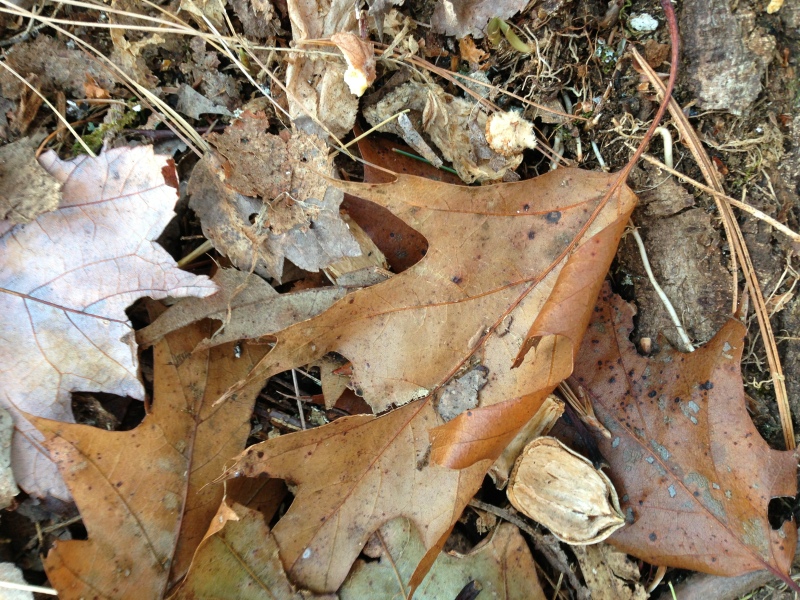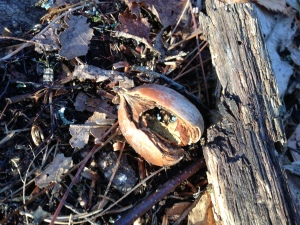A SQUIRREL THANKSGIVING
As snow piles up here at the Harvard Forest on the evening before Thanksgiving, I think about all the furtive activity I watched in the gathering time of this fall. All around me, animals tucked away seeds, nuts, and acorns, readying for the onslaught of snow now underway.
Blue jays swooped across broad open swales of the pasture out my window to reach oak trees that promenade along the stonewall, then zipped back to the forest with their prize clenched tight in their beak. What I didn’t know then is that this sort of long distance dispersal is just what oak trees depend on to spread their seed beyond the realm of their own crown.
Sitting still under the big oak I am studying at the Harvard Forest, the stonewall by which that tree sprouted in about 1905 proved a busy chipmunk highway. I startled more than a few of them, bright-eyed, and silky furred, while on an urgent errand with an acorn.

Remnants of a delectable acorn feast under the oak tree I am studying at the Harvard Forest, before the snow flew this month. Squirrels and blue jays are important dispersers of oak acorns, enabling seeds to sprout far from crown of the parent tree in the sunshine they need.
Squirrels, it turns out, carefully test acorns for quality before tucking them into their cache. They will also fake burying them to mislead watching competitors, says Mike Steele, associate professor of biology at Wilkes University in Wilkes-Barre, Pa. Steele studies the ecological and evolutionary interactions between jays, squirrels and other rodents that disperse seeds and acorns. “I became very interested in what animals do with the seed, and the results of that behavior in the establishment and regeneration (of trees),” Steele said.
Oaks are shade intolerant, and their seedlings fare poorly under the parent tree. To make a go of it, somehow the acorn has to germinate a distance from the parent tree. Enter the delicate balance, Steele says, between the oak, the jay, and the squirrel. The oak needs the acorn to be attractive enough to the jay or squirrel that it will pick it up and carry it to a cache – but not so much so that there will be none left to create a new generation of oaks.
In the oaks’ favor is the animals’ imperfect memory. Many a tree owes its life to the forgetfulness of squirrels. But their memory is still mighty good. Grey squirrels, Steele says, triangulate the location of a cache based on stationary objects. Putting the squirrels in captivity to test their memory, Steele found even three weeks later they would immediately find their food stash. Consider that the next time you walk into a room to do or get something, and can’t remember once you arrive why in the world you went in there.
Squirrels are quite discriminating, moving the largest, choicest acorns furthest from their source – the smaller ones aren’t worth the effort. That’s also good for the tree of course, with the most viable seeds winding up furthest from the parent. As so-called scatter hoarders, squirrels also create many caches, not a single trove – another plus for sure-fire dispersal.
The animals even risk higher predation risk to bury a choice find, operating out in the open to do so – perfect for a tree that needs sun. They work very hard at their task, regularly checking on and even moving their caches to safeguard them. They will even deliberately mislead competitors, pretending to hide an acorn, pushing it into the ground. But an animal that follows to the spot to dig it up will find…nothing. “What we found suggests that squirrels are engaging in functional deceptions,” Steele said. “In any video tape, you would swear they are going through the same routine,” of burying a cache.

Notice this moldy acorn was sampled and left behind. Animals are very discerning, testing acorns for weevils or other damage before bothering to cache them.
Squirrels are also extremely sensitive to insect-infested acorns. A squirrel will do a very rapid head shake of an acorn to assess the seed quality before bothering to take it. Researchers determined through X-ray examination of the acorns that the squirrels were identifying weevil-infested nuts with about 92 percent accuracy. “They selectively cache the sound ones,” Steele said.
Apparently once the weevil feeds on the cotyledons within the acorn, it is no longer the same, nice, tightly-packed package of nutrition. The animal can detect the looseness with a head shake that is so rapid, researchers had to slow down their videotape playback to detect it.
“There is one surprise after another,” Steele said. “I couldn’t have sat around and made this up.” Next he is interested in researching how the landscape of animals’ fear – how far they are willing to venture from their nests and burrows to find and stash food – influences the dispersal and growth patterns of forests. Since, after all, the seed dispersal work of animals is tightly linked to the success of the sprouting of the next generation of trees. It’s no minor enterprise: Steele says he has watched animals make 8,000 acorns disappear in 48 hours.
So as you feast this Thanksgiving, there is one more thing to be grateful for: The industry of the animals, planting the next generation of forest as they tuck away a feast of their own.

Leave a Reply